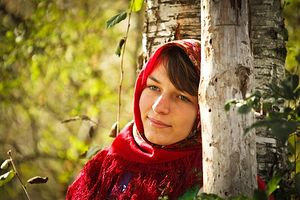SOURCE: Opposing views
by Allison Troy

|
| A Russian Orthodox woman wearing a traditional scarf. Photo: Yulia Smorodova. |
Women's Dress: Origins
The issue of women’s dress is one way to compare and contrast the practices of Orthodox Christian and Muslim women. Ruhi Hamid, in her documentary "Islam Unveiled," claims that Muslims were influenced by Byzantine Christians: In early 700, Orthodox Christian women wore head coverings in accordance with the Apostle Paul’s command in 1st Corinthians for women to cover their heads in public worship. Both religions require women to cover their heads in public and to dress "modestly" for public worship and interactions.
Orthodox Women and the Veil
In contemporary Orthodox Christianity, the ways that women dress differ in terms of their parish’s history and geographical location. Most women do not wear a full head covering, or veil, in many parishes across North America. Orthodox churches with an older immigrant population, particularly from Russia or Greece, however, will often require women to wear a head covering of some kind. Matushkas, or priests’ wives, can be required to wear head coverings in the presence of a bishop. It is more common for Orthodox women in non-Western settings to cover their heads.
Muslim Women and the Hijab
In Islam, much of the expectation for women wearing the veil, or hijab, comes from the Quran’s demands for purity of all believers; it is also widely taught that men, as the traditional leaders of Muslim families, must be protected from any sexual attraction they might encounter while seeing other women. There are also rules for various interactions between men and women -- for example, an unmarried Muslim woman will often wear the full hijab to cover her face from men in public, whereas a married Muslim woman, depending on her country’s adherence to Muslim teaching, can go into public with her face uncovered.
Protocol for clothing, particularly in Islam, has become a symbol for what many outside these traditions see as a repression of women’s rights. At the same time, many women in both Islam and Orthodox Christianity would claim that the hijab (for Muslims) and the veil (for Orthodox women) are, in fact, representative of their spiritual freedom.
Women in the Public Sphere
While Orthodox Christianity and Islam practice strict adherence to their traditions’ teachings about the submission of women in public speaking and community leadership, both traditions also give high regard to historical women who modeled a high level of spiritual devotion. The Virgin Mary, or Theotokos, is highly revered by the Orthodox, as are numerous female saints whose stories are depicted in icons, church teachings and hymns. In Islam, the Prophet Muhammed’s wives are seen as the “Mothers of Islam,” and their burial sites are visited as holy places by devout Muslims.
In both traditions, women are not ordained as clergy. Orthodox Christian women serve as teachers, public leaders and musicians, and were recognized as deacons in the early Christian church. Muslim women worship separately from men, and are often given sole charge of women converts’ spiritual instruction. These differences and similarities open a broader window into the lives of religious women in both Orthodox Christianity and Islam.

